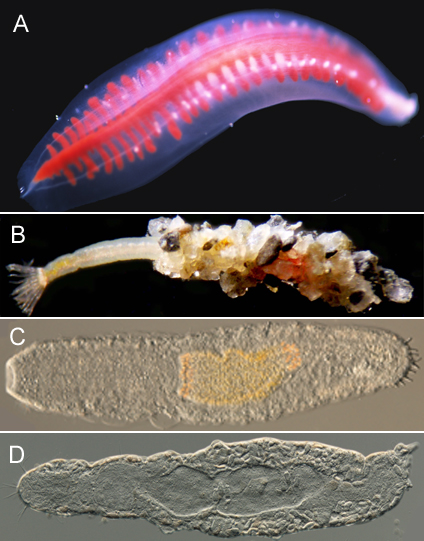KAJIHARA, HiroshiProfessor
One of our goals is to clarify the marine invertebrate fauna around Japan. I specialize in taxonomy of Phylum Nemertea (ribbon worms), which comprises about 1200 species distributed worldwide, mostly in marine benthic habitats, though some species have adapted to live in pelagic (Fig. A), freshwater, or land habitats. To date, around 120 species have been recorded from Japanese waters, but we estimate the actual diversity to be more than double this figure. In addition to nemerteans, I have collaborated with colleagues and students on Holothuroidea, Phoronida (Fig. B), Gastrotricha (Fig. C), Crustacea (Tanaidacea), Nematoda, Acari (Hygrobatidae), and Bryozoa. Ongoing projects include descriptive taxonomy of representatives of Pycnogonida, Kinorhyncha, Polychaeta (Sabellidae), Platyhelminthes (Kalyptorhynchia), and the enigmatic interstitial archiannelidDiurodrilus (Fig. D), whose relationship to existing phyla is unclear. We aim to reveal evolutionary relationships among these invertebrates, based both on molecular phylogenetics and comparative/functional morphology.

A. Dinonemertes shinkaii Kajihara & Lindsay, 2010 (Nemertea: Hoplonemertea: Polystilifera: Pelagica) collected by the manned submersible Shinkai 6500 from a depth of 2343 m in Japan Trench (photographed on board the research vessel Yokosuka by Dr Dhugal J. Lindsay) . B. Phoronis psammophila Cori, 1889 (Phoronida) collected among sandy sediment at about 80 cm in depth, Ikarise, Lake Hamana, Shizuoka Prefecture (photographed by Dr Masato Hirose). C. An undescribed cephalodasyid macrodasyidan (Gastrotricha: Macrodasyida: Cephalodasyidae) from groundwater of Ishikari Beach. D. An undescribed species of Diurodrilus (Phylum incertae sedis) from groundwater of Ishikari Beach.
The driving force for research in natural science is joy in discovery. As a researcher in marine-invertebrate systematics, you will encounter moments of pleasure when, for example, you find your target animals in the field, observe unexpected morphology or behavior, discover an undescribed species, or recognize a new higher taxon. There are many marine invertebrate taxa with which you can enjoy the pleasure of discovery, because research is insufficient in many of these groups. In addition, there is room for developing methods to make effective use of taxonomic research to benefit society. I hope that many people in younger generations will aspire to become systematists.
References
- Asakawa, M., Ito, K. and Kajihara, H. 2013. Highly toxic ribbon worm Cephalothrix simula containing tetrodotoxin in Hiroshima Bay, Hiroshima Prefecture, Japan. Toxins5(2): 376–395.
- Kajihara, H. and Kuris, A. M. 2013. Ovicides paralithodis (Nemertea, Carcinonemertidae), a new species of symbiotic egg predator of the red king crabParalithodes camtschaticus (Tilesius, 1815) (Decapoda, Anomura). ZooKeys 258: 1–15.
- Yamasaki, H., Hiruta, S. F. and Kajihara, H. 2013. Molecular phylogeny of kinorhynchs. Molecular Phylogenetics and Evolution 67: 303–310.
- Andrade, S. C. S., Strand, M., Schwartz, M., Chen, H., Kajihara, H., von Döhren, J., Sun, S.-C., Junoy, J., Thiel, M., Norenburg, J. L., Turbeville, J. M., Giribet, G. and Sundberg, P. 2012. Disentangling ribbon worm relationships: multi-locus analysis supports traditional classification of the phylum Nemertea. Cladistics 28: 141–159.
- Kajihara, H., Yoshida, R. and Uyeno, D. 2012. First record of Baseodiscus mexicanus (Bürger, 1893) (Nemertea: Heteronemertea) from Japanese waters. Check List 8(4):754–755.
Faculty
Faculty of Science
Department of Biological Sciences
Biodiversity
Grad School
Graduate School of Science
Department of Natural History Sciences
Biodiversity I
Contact Information
Faculty of Science, Building #5 5-510
Email: kajihara ![[atmark]](https://www2.sci.hokudai.ac.jp/dept/bio/wp/wp-content/themes/sci-bio_2407/img/atmark.png) eis.hokudai.ac.jp
eis.hokudai.ac.jp
